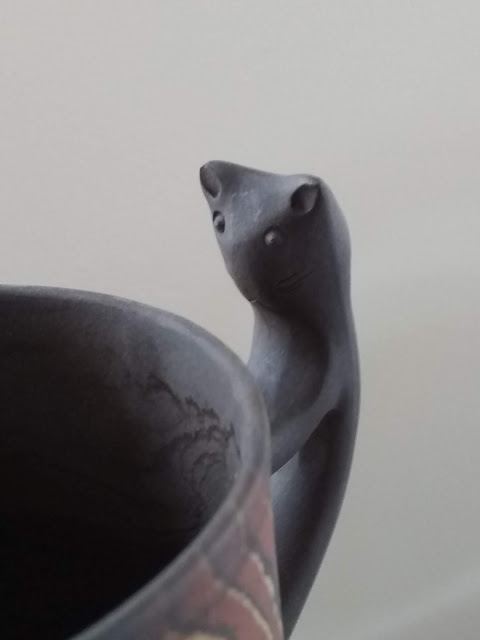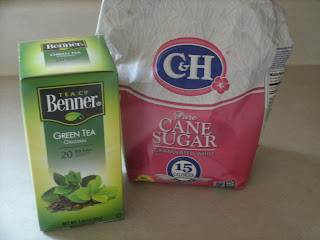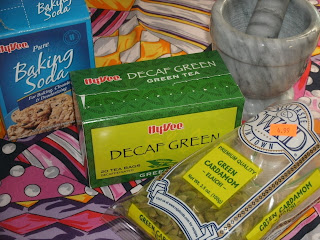Yixing
Since I never got around to posting anything last week, I figured I better get off my behind and post something this week. To say that I have been less motivated about life in general would be an understatement. I did make it to the grocery store this morning. I was amazed to see that there were paper towels and toilet paper. Still no sanitizing wipes or bottles of hand sanitizer, but they did have small jugs of bleach. Progress, I guess.
I decided to drink with a friend today. A decidedly un-furry friend, although most of them do have fur.
I'm referring of course, to my Yixing mug with a cat for a handle. I bought this mug last summer. It was on clearance because it had a chip on it. I didn't see any chips on it when I was at the store, and I love cats, so I got it. I eventually found there is a chip about the size of a pin head under the cat's armpit. Not a problem for me (and saving a significant amount of money was a nice perk).
Yixing tea ware is made of an unglazed clay from the Yixing area of China. It requires some special care. First off, you NEVER use soap on Yixing. The clay vessels are boiled to clean and season them. The clay absorbs the tea as you use it over time, and it is said that you can make a passable cup of tea with an antique Yixing pot and hot water. For this reason, purists say that you should only brew or drink one type of tea in your Yixing ware. Also, certain clays pair better with certain types of tea. Yes, not only do tea enthusiasts have food pairings for teas, we have clay pairings for teas! I doubt that I will ever have tea sets from all the different types of unglazed clay used around the world, but Yixing is pretty widely available.
Who needs to play with their food when they can play with their dishes? I guess it's destiny that the only cat mug they had was one that was on clearance. I also like that they did give the cat some facial features, even though they are shallowly carved into the clay. There is a nose there, along with a mouth, whiskers, and the clearly visible eyes. One thing is for certain, cats are the same no matter where you go in the world.
I decided to drink with a friend today. A decidedly un-furry friend, although most of them do have fur.
I'm referring of course, to my Yixing mug with a cat for a handle. I bought this mug last summer. It was on clearance because it had a chip on it. I didn't see any chips on it when I was at the store, and I love cats, so I got it. I eventually found there is a chip about the size of a pin head under the cat's armpit. Not a problem for me (and saving a significant amount of money was a nice perk).
Yixing tea ware is made of an unglazed clay from the Yixing area of China. It requires some special care. First off, you NEVER use soap on Yixing. The clay vessels are boiled to clean and season them. The clay absorbs the tea as you use it over time, and it is said that you can make a passable cup of tea with an antique Yixing pot and hot water. For this reason, purists say that you should only brew or drink one type of tea in your Yixing ware. Also, certain clays pair better with certain types of tea. Yes, not only do tea enthusiasts have food pairings for teas, we have clay pairings for teas! I doubt that I will ever have tea sets from all the different types of unglazed clay used around the world, but Yixing is pretty widely available.
I boiled my teacup in plain water last summer. Then I started boiling it with spent pu erh tea leaves to start seasoning it (if you watch the video, Yixing pairs well with pu erh teas). Then I cleaned my counter and the mug got put on a high shelf. So today I decided to give it a try. I did some research on the brand, trYeh. It is referred to as "tourist" grade, which is the lowest grade of Yixing ware. The general consensus is that it is genuine Yixing clay, but is a slip cast, mass produced product. Serious tea drinkers want one of a kind, hand made pots. I don't have that kind of budget.
My review of the cup is that the walls are quite thin, and I don't trust the handle alone to support the cup. It's not that the handle seems flimsy or poorly attached, rather, having dealt with hand made pottery, I know that applied pieces sometimes come off with very little pressure, and it looks like the animal handles are applied after the body of the cup is made. As for the taste of the tea, it really smooths out the flavor of plain pu erh tea. It still has the funky, aged quality to it, but it is mellowed out quite pleasantly. I've recently found a place to keep it safe in a lower part of the cupboard, so hopefully I will be using it more since it is more accessible.
 |
| Hi! |





Hi, kitty!
ReplyDeleteLike you, it didn't think I was drinking anything worth stealing a taste of.
Delete